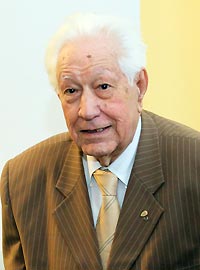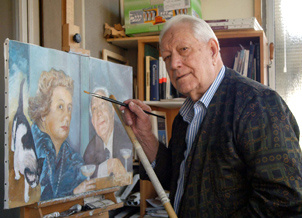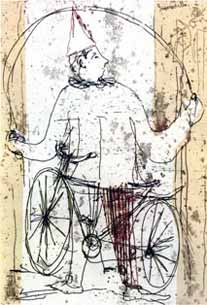Painter, engraver, set designer, director of the Academy of Fine Arts Nunzio Sciavarrello Always determined to constantly devise new initiatives. In addition to teaching and intense artistic activity, he also joined a constant social commitment, of which Bronte was not a stranger  Nunzio Sciavarrello, painter, engraver, scene-designer, director of the academy of beautiful arts of Catania, was born in Bronte on May 23rd, 1918. At present he lives and works in Catania. Nunzio Sciavarrello, painter, engraver, scene-designer, director of the academy of beautiful arts of Catania, was born in Bronte on May 23rd, 1918. At present he lives and works in Catania.
Has had several "personal exhibitions" and participations to Biennial in Venice, Biennial in national San Paolo of Brazil and Lubiana, Quadriennal of art of Rome and very many Italian and foreign art shows organized by the national Chalcography of Rome and Italian culture institutes. Resolute and determined in his love for art and culture, attends, at ten years of age, the municipal evening School of drawing of Bronte, works as apprentice to a local decorator artisan and in 1936, eighteen years old, moves to Rome. In Rome he attends the free Via Margutta school, follows the studies near the Academy Of Beautiful Arts and is interested to the problems of the "Roman school " living his most fecund moments (with Scipione, Mafai, Pirandello). In 1940, he realizes the first etchings at the school of Mino Maccari. Returned to Bronte after the war, in which he takes part as a Grenadier, prints the, by now legendary, newspaper "The Ciclope", satirical fortnightly magazine that reflects and clarifies the essential and urgent problems of the country town and will, significantly, take a big part of the town life (1946-1950). Moved to Catania, modifies the rhythm of the artistic activity and, with a group of artists who have for their meetings the Caffe' Italia - at the center of the via Etnea - promotes the birth of the State Art Institute (1950). In 1963 he becomes full professor of etching to the Academy of beautiful arts of Palermo, of which, in 1966, will also assume the direction. Since 1967 he has been a director of the homonymous Academy Of Catania. In 1975 he is rewarded with gold medal of the Chairmanship Of The Republic, as well deserving of culture and art. Nunzio Sciavarrello certainly represents one of the personalities that were able to give an indifferent contribution to the most significant cultural and contemporary art events in Sicily, and he is among the most representative figures of the Italian etching.  His etchings of 1943-44, dedicated to freedom and referable to the resistance art, make us understand how intense and deep is the feeling with which he tries to study and understand the human condition: in them there is Bronte with his perennial yearning for freedom, independence and justice. His etchings of 1943-44, dedicated to freedom and referable to the resistance art, make us understand how intense and deep is the feeling with which he tries to study and understand the human condition: in them there is Bronte with his perennial yearning for freedom, independence and justice.
Among his most significant works we remind of "Panic on the Etna" (dry point of '45 and oil of '47), "The conjurer" (of '74), "Woman to the mirror" (oil of '77), "Moments to the circus" (it does part of a series of big pictures in oil of 1978 dedicated to the circus and the clowns), "The Paladins" (five etchings to six colors of 1971), "Dead nature with fish" (oil of '77) and the other moving works dedicated to flowers, to seagulls, to farmers and to landscapes. Always determined and determined in constantly devising new initiatives, teaching and intense artistic activity (he was, as said, also set designer and costume designer), Nunzio Sciavarrello has also joined a constant social commitment, of which Bronte was not a stranger. Among the many initiatives that deserve to be mentioned are the "Exhibition of Bronte's Artists of Yesterday and Today" (Collegio Capizzi, 1973) and the International Sculpture Symposium with the theme "La Liberta", held in the premises of the Nelson Castle from 27 September to 7 October 1990.  The sculptures created by artists from around the world now make up the first open-air museum of lava stone sculptures. The sculptures created by artists from around the world now make up the first open-air museum of lava stone sculptures.
His last enlightened and courageous initiative was to raise a public Art Gallery in Bronte (to which he donated hundreds of works from his collection) and an attached restoration school to be hosted in the premises of the Real Capizzi College. After more than ten years of solicitations and constant effort, the works were concluded in 2010, the Pinacoteca was named after Nunzio Sciavarrello and inaugurated in October in the same year. The contrasted landscape of Bronte, his churches, the small streets and the houses with their lively colors and the flowery balconies were often the favorite subjects of the etchings or some paintings of Nunzio Sciavarrello. A large painting, with doves in flight and a wonderful view of the country taken from the top of Monte Colla, adorns and lights up the gray salon of Banca Mutua Popolare in Bronte.
At the headquarters of the same bank (now Banca Popolare Italiana) there are also five etchings of the "I paladini" series and other important works by the master Sciavarrello (I clown, etc.). It is worthwhile to join the bank just for this! |